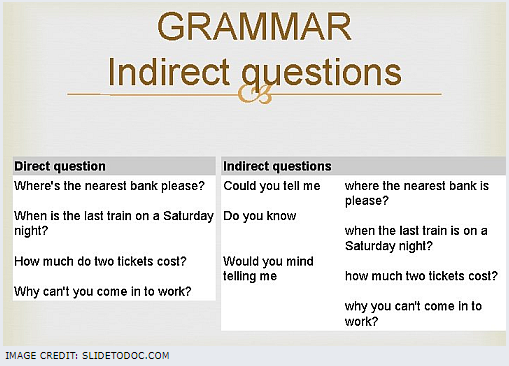You’re all by yourself at an MRT station or bus stop when a total stranger suddenly walks to just a few inches of you and blurts out this question close to your face: “What time is it?” No matter how harmless or decent-looking the stranger, you’d likely feel a deep sense of intrusion, as if somebody has just barged into your bedroom from the outside in the dead of night. You may not say a word, but your sense of violation would be real. This is because when asked direct questions like “What time is it?” point-blank, the preliminary amenities neglected, people instinctively resist answering and oftentimes become downright hostile.
This is where the art of asking indirect questions comes in. Using them instead of direct ones in socially unstructured settings has the pleasant effect of “breaking the ice,” so to speak. It lowers resistance to intrusion on privacy and prompts people to give the requested information willingly and without aggravation. Thus, in the situation described above, you probably would have obliged the stranger with the desired information had he used this classic indirect question, “Hi! I wonder if you can give me the time,” or, with less familiarity, “Excuse me...May I know what time it is?”

Although indirect questions clearly ask for a response, they don’t necessarily need a questioning intonation when actually spoken, nor end with a question mark when in written form. The first indirect question above, for instance—“Hi! I wonder if you can give me the time”—doesn’t look like and isn’t in the form of a question at all. It’s an indirect statement that embeds a question word to reduce the sense of forthrightness. Its basic structure is this: Indirect statement = [indirect phrase] + [question word] + [statement]. In the given example, the indirect phrase is “I wonder,” the question word is “if,” and the request statement, “you can give me the time,” is by semantic design already worded in the affirmative. This psychologically predisposes people to make an unstated “yes” and unthinkingly give the requested information. “It’s 9:25,” you’ll probably reply, thinking nothing more of it.
The more formal and polite way to put an indirect question, however, is to use a phrase followed by a statement, in a construction that—unlike in a direct question—doesn’t invert the subject and verb or use an auxiliary verb: Indirect question = [indirect phrase] + [statement]. By taking the form of a real question with a modified question embedded in it, an indirect question like the following profoundly attenuate the oftentimes irritating forthrightness of a direct question: “Do you know how long the trip will be to the Banaue Rice Terraces?” (How long is the trip to the Banaue Rice Terraces?”).
For an indirect question that we want answered with a simple “yes” or “no,” we can use an indirect construction with an “if” embedded in it, as in the first indirect question we discussed: Indirect question = [indirect phrase] + “if” + [statement]. “Would you ask her if she is interested in the job?” (“Does she want the job?”). “Could you tell me if this is the store that sells jade bangles?” (“Is this the store that sells jade bangles?”).
The difference between indirect questions and direct questions may look deceptively superficial, but the superiority of the former in eliciting a positive response simply can’t be underestimated. Indirect questions are definitely not only a much more civilized way of getting information from strangers and acquaintances alike but are much more efficient ones at that. To become more pleasant and effective communicators, we will thus be much better off cultivating the art of asking indirect questions rather than just banking solely on the conciseness of their direct counterparts.
This essay, 2107th of the series, appeared in the column “English Plain and Simple” by Jose A. Carillo in the Campus Press section of the July 14, 2022 digital edition of The Manila Times
, ©2022 by the Manila Times Publishing Corp. All rights reserved.Read this essay online in
The Manila Times:
The grammar of indirect questions(Next week:
Saying our tag questions right) July 21, 2022
Visit Jose Carillo’s English Forum, http://josecarilloforum.com. You can follow me on Facebook and Twitter and e-mail me at j8carillo@yahoo.com.